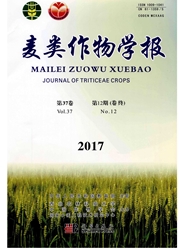

 中文摘要:
中文摘要:
为了分析锌强化对不同小麦品种籽粒矿质元素含量的影响,以40个不同小麦品种(系)为材料,在扬花期叶面喷施0.5%的Zn肥,用原子吸收光谱法测定Zn处理与不处理(对照)下不同小麦品种籽粒中6种矿质元素(Zn、Fe、Ca、Mg、Cu、Mn)的含量,并分析这些元素对Zn强化的响应。结果表明,Zn处理后各品种籽粒中Zn含量均比对照有极显著上升,但上升幅度因品种而异。籽粒中Fe、Ca、Mg、Cu、Mn含量对Zn强化的响应因元素种类和品种而异,就品种平均值而言,Mn含量在Zn处理和对照间有极显著差异,Fe、Mg和Cu含量在处理与对照间无显著差异。大部分品种Zn处理后籽粒Ca含量有所下降,Mn则有所增加。对施Zn和对照间被测矿质元素的变幅进行主成分分析,前三个主成分(PC1、PC2、PC3)累积贡献率为0.76,基于前三个主成分对40个品种(系)进行类平均法的聚类分析,将40个品种分为3类:第1类包含有8个品种,Zn处理后籽粒中Ca、Mg、Cu、Fe含量总体呈现降低趋势,而Mn、Zn含量呈增高趋势;第2类包含23个品种,Zn处理后籽粒Ca、Cu含量总体有一定的降低,其余4种元素含量则有一定幅度的提高;第3类共有9个品种,施Zn后Fe含量总体有一定幅度的降低,其余5种元素含量则有一定幅度的增加。来自第2类和第3类中的12个品种在Zn处理后所测定的全部6种元素或者其中大部分元素的含量提高,适宜进行Zn强化,而其余品种Zn强化后部分或全部元素(Zn除外)与对照相比有所下降,不宜作为Zn营养强化的载体品种。
 英文摘要:
英文摘要:
Zinc(Zn)is an essential mineral element that is required for the development and growth of plants and animals.Wheat is one of the staple food crops both in China and in the world.Biofortification of wheat is one of the promising strategies for increasing the amount of Zn in the diet.In this study,the contents of six mineral elements including zinc(Zn),calcium(Ca),magnesium(Mg),copper(Cu),iron(Fe)and manganese(Mn)in wheat seeds of forty cultivars(or inbred lines)in the treatments with foliar spray of ZnSO4·7H2O(0.5%)and the controls were determined by ICP method to understand the effects of Zn biofortification.The main results are as followings:Significant differences in the concentrations of Zn and Mn were observed between the Zn fortified samples and their controls.In general,Zn fortification reduced the density of Ca whereas increased the concentration ofMn in the seeds when compared with their counterparts.Concentrations of Ca,Cu,Fe and Mg did not differ significantly between the Zn fortified samples and their controls.However,there were genotypic differences in their responses of the elements to Zn application.The cultivars fell into three distinct groups based on the first three principle components according to their changes caused by Zn fortification.Group 1consisted of eight cultivars and the concentrations of most of the six elements(except for zinc)in the Zn-fortified samples were lower than those in their controls,thus may not be good candidate cultivars for Zn fortification.Group 3consisted of nine cultivars with most of mineral elements in zinc biofortified samples higher than those in their respective controls and could be promising candidates for zinc fortification.Part of the cultivars in group 2can be used for Zn biofortification depending on the biofortification purposes and the mineral bioavailability in the soil.In summary,both the synergistic and antaganistic effects of Zn biofortification on other minerals were observed depending on genotypes.
 同期刊论文项目
同期刊论文项目
 同项目期刊论文
同项目期刊论文
 期刊信息
期刊信息
